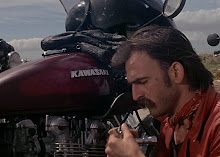One could point to the Triumph Trident, and its twin the BSA Rocket 3, as the first superbike. When they debuted in 1968, they were the fastest thing you could buy on the road. They were also the first mass-produced multi-cylinder motorcycle of the modern-era.
Those people who say the Trident/Rocket 3 is the first superbike are wrong, however.
One could also point to the Honda CB750 as the first superbike. In 1969, the CB750 was a space-ship in a world of paper airplanes. It had four cylinders, four carbs, the first factory disc brake and cost less than the Triumph/BSA triples. It also had more power too; 67hp for the Honda versus 58hp for the three cylinder Triumph.
Alas, those who say the CB750 is the first superbike are wrong too.
No, to find the first superbike, you have to go further back than 1968. You have to go past the 1959 Triumph Bonneville, past all of the sporting British singles, past the four cylinder Gilera's and the Moto Guzzi V8 and land in the small English town of Stevenage.
In a shed, in 1948, you'll find the first superbike. Here, you'll find genesis.
You'll see the black enamel V-twin matching the black gas tank. There are the polished alloy fenders, four drum brakes and low handlebar. The innovative rear suspension and large, round speedometer catch your eye.
The machine in question is the beginning, the grandfather of all modern superbikes. It is the Vincent Black Shadow.
The Black Shadow was unlike anything on the road in 1948. It featured many innovations that would become standard on superbikes of the future.
The Black Shadow, and the tamer Rapide, had a cantilever rear suspension like you'll find on many modern sportbikes and the Harley-Davidson Softail. Most of the other motorcycles on the road at that time had no rear suspension at all. Your spine was the rear suspension.
The Black Shadow's drivetrain was of unitized, alloy construction when many contemporaries used iron and had a separate engine and transmission. The 1,000cc V-twin had its compression ratio upped and delivered 55hp compared to the Rapide's 45hp.
The powertrain also acted as a stressed member of the frame. The entire motorcycle was basically bolted to the engine. Walk in to any motorcycle dealer and look at their sport models. Guess what you'll find: an alloy, unitized engine as the stressed member of the frame.
The "black" in the Black Shadow's name comes from its all-black appearance. The only other colors on the bike were the polished fenders and the white numbers on the speedometer. It was very menacing, to say the least.
A motorcycle like this is a natural for competition and Vincent did just that with the Black Lightning. Weight was trimmed to 380lbs and the engine was pumped up to 70hp. Race-track domination ensued.
In 1948, American Rollie Free strapped on a bathing suit, jumped on a modified Black Lightning and rode it to a record 150.313mph pass. Two years and several modifications later, Free broke his own record on the same Black Lightning with a 156.58mph pass.
All of this tech came at a price, a high price.
The Black Shadow cost as much as some cars and was never a big seller. Only 1,700 Black Shadows and 31 Black Lightnings were produced before the Vincent factory closed in 1955.
The funny thing is, they're still expensive. Black Shadows typically trade hands for around $100,000 now.
The Vincent Black Shadow is one of those truly great machines. Just as all supercars can trace their roots to the Lamborghini Miura, all superbikes can trace their roots to the Vincent Black Shadow. To call it a legend is to undersell its importance.
The Vincent Black Shadow is the grandfather, the alpha, the genesis of the superbike.
This is a 1950 Vincent Black Shadow Series C. This is the final version of the Black Shadow before Vincent closed its doors in 1955.
This is probably the most famous motorcycle picture ever; Rollie Free making his 150mph pass on a Black Lightning. The story goes he gained 2mph by removing the seat and his clothes. Bravery or insanity? You decide.



No comments:
Post a Comment